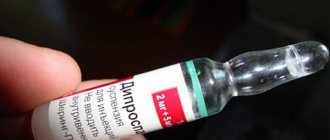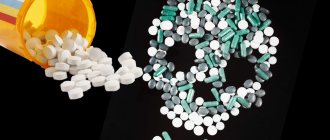pharmachologic effect
Antihypoxic, antiaggregation, neuroprotective, vasodilator, improves cerebral circulation.
Pharmacokinetics
Suction
After oral administration, it is quickly absorbed. Cmax in blood plasma is achieved 1 hour after administration. Absorption occurs mainly in the proximal gastrointestinal tract. When passing through the intestinal wall it is not metabolized. Cmax in tissues is observed 2-4 hours after oral administration. Bioavailability is 7%.
Distribution
With repeated oral doses of 5 mg and 10 mg, the kinetics are linear.
Binds to plasma proteins by 66%. Penetrates through the placental barrier.
Metabolism and excretion
Clearance of 66.7 l/h exceeds the plasma volume of the liver (50 l/h), indicating extrahepatic metabolism.
T1/2 is 4.83±1.29h. Excreted in urine and feces in a ratio of 3:2.
Pharmacodynamics
Improves brain metabolism by increasing the consumption of glucose and oxygen by brain tissue. Increases the resistance of neurons to hypoxia, enhancing the transport of glucose to the brain through the BBB; transfers the process of glucose breakdown to the more energy-efficient aerobic pathway; selectively blocks Ca2+-dependent phosphodiesterase; increases levels of AMP and cGMP in the brain. Increases the concentration of ATP and the ATP/AMP ratio in brain tissue; enhances the exchange of norepinephrine and serotonin in the brain; stimulates the ascending branch of the noradrenergic system and has an antioxidant effect.
Reduces platelet aggregation and increased blood viscosity; increases the deforming ability of red blood cells and blocks the utilization of adenosine by red blood cells; helps increase oxygen delivery by red blood cells. Strengthens the neuroprotective effect of adenosine.
Increases cerebral blood flow; reduces the resistance of cerebral vessels without significant changes in systemic circulation parameters (BP, minute volume, heart rate, peripheral vascular resistance). Not only does it not have a “stealing” effect, but it also increases blood supply, primarily in ischemic areas of the brain with low perfusion.
Chemical composition and dosage forms
The active compound of the drug is vinpocetine. It has a vasodilator (vasodilator), antioxidant, neuroprotective effect, stimulates metabolic processes in tissues, and normalizes the rheological properties of blood.
Cavinton is produced in two pharmaceutical forms:
- Tablets: in blisters, white, with the Cavinton inscription engraved on the surface, the dosage of the active substance is 5 mg. Auxiliary components of the drug: silicon dioxide, talc, magnesium stearate, starch.
- Infusion solution in ampoules of 2 and 5 ml, used intravenously. In addition to vinpocetine, it contains distilled water, ascorbic and tartaric acids, and sorbitol.
Indications for use of Cavinton forte
Neurology: to reduce the severity of neurological and mental symptoms in various forms of cerebral circulatory failure (including conditions after an ischemic stroke, the recovery stage of hemorrhagic stroke, the consequences of a stroke, transient ischemic attack, vascular dementia, vertebrobasilar insufficiency, cerebral atherosclerosis , post-traumatic and hypertensive encephalopathy).
Ophthalmology: chronic vascular diseases of the choroid and retina.
Otorhinolaryngology: for the treatment of perceptual hearing loss, Meniere's disease, idiopathic tinnitus.
To avoid complications, use strictly as prescribed by your doctor.
The drug Cavinton - reviews
Nuria
I started drinking Cavinton and developed severe heartburn on the 2nd day and stopped.
Lena
For speech disorders, memory loss, headaches, my mother was prescribed Cavinton. Unfortunately, the medicine caused tachycardia. I had to change it, despite its effectiveness. As an alternative, Mexidol was prescribed intramuscularly. It does not affect the gastrointestinal tract or the heart. It is easily tolerated by the body. At the same time, it works no less effectively. Speech has become clearer, mom recognizes her loved ones, and she no longer confuses names.
Olga
Cavinton was prescribed to reduce the manifestations of VSD. Unfortunately, individual intolerance to the drug was discovered. The neurologist replaced it with Mexidol injections, since I’m afraid to take pills (I had a negative experience, the ulcer worsened). I noticed an improvement in my condition only after the second course of treatment. I sleep normally, cope with a large flow of information at work, fainting and dizziness have stopped.
Raisa
Mom was prescribed Cavinton to relieve weakness headaches associated with poor blood circulation to the brain. Mom took the medicine with discipline for a month, but did not see any noticeable results. There was no deterioration either, but I stopped taking it. The neurologist recommended the domestic drug Mexidol. The result became noticeable after 10 days. The dizziness at first became less intense, and then stopped altogether, and my mood somehow became better, because it’s great when nothing bothers you anywhere.
Anna
I started taking Kaviton on the advice of a neurologist friend. My problems are frequent headaches, nervousness, and strong constant noises in my head. I’ve been drinking for the third day. After taking it, I want to sleep within half an hour. I’ve never had a headache, which is a huge plus. And lo and behold, for the first time in many years, the noise in my head has decreased and I can hear better. So far there are no side effects other than drowsiness, but positive ones I felt the effects already on the third day! I’ll write later whether it helped completely cure my problems. I drink Cavinton Hungarian regular not forte 5 mg.
Elena Zueva (Balalicheva)
https://flap.rf/Medicine/Cavinton/Reviews/7132341
Cavinton. Application. My experience.
I have a bunch of ailments, including a cerebrovascular accident.
In this regard, I have to take a course of Cavinton drips once a year.
The active ingredient of the drug Cavinton is Vinpocetine.
He really helps me. After the IVs, my head feels much better. Dizziness and stiffness are reduced. The head becomes clear and overall health improves.
This all happens thanks to the action of Cavinton, which improves cerebral circulation.
Lately it’s been difficult to get to the hospital for IV drips, so I’ve been taking Cavinton tablets for 2 months each. The effect occurs more slowly compared to intravenous administration, but gradually an improvement occurs when taking tablets.
Cavinton can be bought at any pharmacy. It's not cheap. Therefore, from time to time I replace it with a cheaper analogue, the drug Vinpocetine.
belaya000
https://otzovik.com/review_5464825.html
Advantages:
- It suited me and that's a plus.
- not very expensive 300r
Flaws:
- I didn’t discover it for myself.
This drug was prescribed to me by a therapist; I complained of numbness in the neck and anxiety, and unpleasant sensations of movement and goosebumps in my head. But what bothered me more was anxiety and worry. I started drinking and I felt better already on the third day, the unpleasant symptoms disappeared. I was prescribed to drink for a month, I’m still drinking and I hope that these symptoms won’t bother me anymore.
LIKUSHA13
https://irecommend.ru/content/kavinton-effektivno-uluchshaet-rabotu-mozga
Advantages:
- reliable and proven
- improves well-being
I have a long-standing problem with the blood vessels of the brain. Dizziness, stiffness and heaviness of the head often occur, and blood pressure is often elevated.
The neurologist prescribed me to take the drug Cavinton to improve cerebral circulation.
I took it 5 mg 3 times a day after meals for two months.
I didn't notice any immediate effect. My condition began to improve only 2 weeks after starting the course of treatment.
My head began to feel less dizzy and lighter. Even my vitality has improved.
When I was in the hospital for hypertension, I was given IVs with Cavinton.
I felt a noticeable positive effect from them after the second dropper.
I didn’t experience any particular side effects. At the beginning of the treatment there were a few headaches.
In general, I believe that the drug Cavinton effectively improves cerebral circulation and improves the standard of living.
Now twice a year, on the recommendation of a neurologist, I take this drug to maintain my blood vessels in good condition.
olgasparrow
https://irecommend.ru/content/eto-prosto-moe-spasenie-1
Advantages:
- reliable and proven
- improves well-being
Flaws:
- there are contraindications
- price
I started drinking Cavinton for the first time when I was 18 years old. Then I had frequent dizziness and headaches. I turned to a neurologist, and after all the examinations, I was prescribed a course of this drug. I’ll say right away that literally after a couple of days of treatment, I felt an improvement, the headaches became less, and the dizziness was no longer so severe. Well, by the end of the course of treatment, all my alarming symptoms disappeared, and I began to live a full life again.
Now, I drink Cavinton regularly when I have certain symptoms associated with the blood vessels of the brain. Naturally, I do this not without a doctor’s recommendation. I have VSD, which periodically changes its course and symptoms, sometimes it’s a mixed type, sometimes it’s hypothetical. But in both cases, I can’t do without Cavinton. Unfortunately, recently, the price for it has increased significantly and not everyone can buy it.
This drug has a very beneficial effect on the blood vessels of the brain; it is also irreplaceable for various injuries, including concussions. For example, my mother, after a concussion, was also treated with Cavinton and her recovery process went quite quickly.
I certainly recommend this drug, but in any case, you need to consult your doctor, since, in addition to its indications, it also has various contraindications.
(oksy36) Oksana
https://www.imho24.ru/recommendation/6941/#review79974
Good support for the brain after a stroke
Advantages:
- Improves blood circulation
- Lowers blood pressure
- Improves memory and attention
- Treats vestibular disorders
Flaws:
- Price
- Contraindications
My mother-in-law has had her second stroke in the last 2 months. Moreover, the stroke is not extensive, but left-sided ischemic. This means that on the left side of the brain there are vessels that suffer from circulatory problems. Due to this, minor hemorrhage occurs there (micro-stroke).
With such a serious pathology, a person must follow a diet, get more rest and take supportive medications for cerebral circulation. But my mother-in-law doesn’t follow this, so the stroke happened again.
In the hospital, she was prescribed many medications that help her recover from a stroke. Among them was the drug Cavinton. I went to the pharmacy, so I know exactly what medications I needed to buy.
This drug dilates blood vessels in the brain, increases blood circulation, and reduces platelet aggregation. This medicine lowers blood pressure, increases the exchange of norepinephrine and serotonin in brain tissue, and reduces blood viscosity.
Cavinton is effective after a stroke, for memory disorders, dizziness, intraocular pressure, and also for the treatment of the vestibular system.
My mother-in-law took 2 tablets 3 times a day for 10 days. A week later she felt better, she had an appetite, she could talk and even get out of bed. Although at the time of discharge, she still felt dizzy and had tinnitus. Memory and attention were in a deplorable state.
There were no side effects, or the mother-in-law simply did not notice. You should not take this drug if you have coronary heart disease, arrhythmia, or unstable blood pressure.
In complex treatment, this medicine helps restore cerebral circulation after a stroke.
nataliya
https://www.piluli.ru/product/Kavinton_forte/review
Personally, Cavinton helps me with headaches, normalizes blood pressure, improves memory and relieves tinnitus. Therefore, 2 times a year, in spring and autumn, I drink it in cycles and then for six months before the next dose I feel great. I usually take 1 tablet per day for 2 months. And when several years ago I just started treatment with it, I had to take it for 3 months. But now I feel noticeably better.
Inna
https://lekotzyvy.com/review.php?id=2482
Until my son was born, I did not know any medicine at all. But our son was born with cerebral hypoxia and we were immediately transferred from the maternity hospital to the neurological department for newborns, where treatment was immediately started. Then, when we were already discharged, our neurologist prescribed us Vinpocetine every three months. We drank in courses, even though the instructions say that children are not allowed, we still drank. There were no side effects either, the baby tolerated all the treatment well. If all the necessary treatment is carried out before a year, the child can recover, so I was told at the maternity hospital. We not only received treatment for the first year, but also until school and into adolescence. Now my son has grown up and the pills are no longer needed.
Irina D.
https://protabletky.ru/cavinton/#otzivi
In the neurological department, my father was diagnosed with an interesting diagnosis: dyscirculatory encephalopathy. Then Cavinton was assigned to him. My father's biggest concern was dizziness. In addition, I often had headaches and a ringing noise in my ears. First there were intravenous infusions of the drug. Within a week he felt much better, as the dizziness had almost disappeared. After that, for another three months he took Cavinton tablets! . In principle, I am satisfied with the result of the treatment. He says that his head “has become fresher”, even his memory has improved. True, the tinnitus is still present, but its intensity has become less. There were no side effects in our case.
Vladimir
https://razuznai.ru/kavinton.html
I am now 34 years old, 9 years ago I had cerebrovascular disease and felt so bad that words cannot describe it. In the hospital they prescribed (a bunch of) drugs that only made things worse, I thought I wouldn’t get through it until they prescribed CAVINTON, first intravenously through a drip and continuing the course in tablets. I was so happy that I can’t describe it. CAVINGTON helped me a lot (by the way, it has practically no side effects, only minor ones). Since then I haven’t been in the hospital, although they said that I need to undergo maintenance therapy every year.
Today I feel good!
Use during pregnancy and children
Cavinton® Forte is contraindicated for use during pregnancy, because Vinpocetine penetrates the placental barrier. Moreover, its concentration in the placenta and in the blood of the fetus is lower than in the blood of a pregnant woman. When taken in high doses, placental bleeding and spontaneous abortion may develop, probably as a result of increased placental blood supply.
Within 1 hour, 0.25% of the administered dose of the drug is excreted in breast milk. If it is necessary to use the drug during lactation, breastfeeding should be stopped.
How Cavinton works
The instructions for use of the drug inform that vinpocetine belongs to the category of cerebrovasodilating substances. It stimulates metabolism and nutrition of the brain, prevents the development of atherosclerotic lesions, improves the absorption of glucose and oxygen by cells. Cavinton helps improve the functioning of the adrenal glands, helps the exchange of norepinephrine, serotonin and other hormones.
The drug works selectively. Affects cerebral blood volume, reduces resistance of the cerebral vasculature. This process helps restore circulation in tissue areas exposed to ischemia. At the same time, the activity of the general blood circulation does not change. Heart rate and blood pressure levels remain the same after taking the medicine. The so-called reverse steal effect ensures that the affected areas remain viable. Cavinton:
- normalizes blood viscosity;
- reduces excessive platelet aggregation;
- increases cell resistance to hypoxic effects;
- slows down the penetration of adenosine into red blood cells, making them more elastic and preventing breakdown.
The drug tablets quickly dissolve in the stomach and are absorbed into the blood. The effect of the substance reaches its maximum within 1–1.5 hours. The effectiveness of injections is slightly higher. The drug does not accumulate in the body. It is excreted completely, without forming metabolites, along with feces and urine within 24 hours after administration.
Side effects
Side effects associated with the use of the drug were rarely detected.
From the cardiovascular system: ECG changes (ST depression, prolongation of the QT interval); tachycardia, extrasystole (however, the presence of a causal relationship has not been proven, since in the natural population these symptoms are observed with the same frequency); lability of blood pressure, feeling of hot flashes.
From the central nervous system: sleep disturbances (insomnia, increased drowsiness), dizziness, headache, general weakness (these symptoms may be manifestations of the underlying disease).
From the digestive system: dry mouth, nausea, heartburn.
Other: allergic skin reactions, increased sweating.
Nootropic drugs for the treatment of VSD
The main task of nootropic drugs is to activate the elements through which nerve cells – neurotransmitters – communicate with each other. Nootropic drugs contain substances that activate the process of biosynthesis of ribonucleic acid and protein compounds in the central nervous system. They accelerate energy processes in neurons, help reduce the number of free radicals, as a result of which they neutralize the negative effects of oxidants.
For VSD, piracetam and its derivatives (ethiracetam, isacetam, oxiracetam) have been used for many years. New generation nootropic drugs include:
- fezam;
- noopept;
- mildronate;
- phenotropil;
- noben;
- Ceraxon;
- pantocalcin;
- pantogam;
- cortexin.
The nootropic drug "Phesam" for VSD, due to the combination of cinnarizine and piracetam, the drug has an antihypoxic, vasodilating effect, improves blood circulation in the brain, and the functions of the auditory and visual analyzers. The main component of phenibut is aminophenylbutyric acid. This compound, a derivative of phenylethylamine and gamma-aminobutyric acid (GABA), plays an important role in the activity of brain neurons - it normalizes metabolism in nerve tissues and signal transmission between neurons. Phenibut plays an important role in strengthening cortico-subcortical connections. This increases the efficiency of interaction between different parts of the cerebral cortex, which is impaired in patients suffering from VSD. After taking the drug, memory improves, the speed and volume of memorized information increases, and emotional stability increases. In patients with VSD, under the influence of Phezam, the activity of mental processes is stimulated, depression, emotional excitability and irritability are reduced.
Noopept restores memory and enhances cognitive abilities, normalizes the activity of the autonomic nervous system. The drug improves mood, increases vitality, relieves stress and anxiety.
Mildronate for VSD (reviews about the drug are good) is used in the form of tablets for oral administration and injections. It has the following effect:
- increases performance;
- reduces symptoms of mental and physical stress;
- activates humoral and tissue immunity;
- has a cardioprotective effect.
Phenotropil acts on most neurotransmitter systems of the brain. When VSD has the following effect:
- activates the integrative activity of the brain;
- promotes memory consolidation;
- improves mental activity and concentration;
- facilitates learning processes;
- accelerates the transfer of information between the hemispheres of the brain;
- increases the resistance of brain tissue to toxic effects and hypoxia;
- regulates the processes of activation and inhibition of the central nervous system;
- improves mood;
- has anticonvulsant and anxiolytic activity.
Noben improves metabolic processes in the brain. It has an antioxidant effect, a psychostimulating effect and neuroprotective properties. From the first days of taking the drug Noben for VSD, antiasthenic, psychostimulating and antidepressant effects are manifested.
Due to the presence of the main active ingredient citicoline in the composition of the drug, Ceraxon has many effects:
- promotes restoration of damaged cell membranes;
- inhibits the action of phospholipases, preventing the excessive formation of free radicals;
- prevents the death of brain cells.
Pantocalcin is a nootropic and psychostimulant drug. In VSD, it has neurometabolic, neuroprotective and neurotrophic effects. Improves memory, reduces lack of initiative and difficulties that arise when performing everyday activities.
The effect of pantogam in VSD is associated with the presence of gamma-aminobutyric acid in its structure. The drug has a nootropic and anticonvulsant effect. Has the following effects:
- increases the brain’s resistance to the effects of toxic substances and hypoxia;
- stimulates anabolic processes in neurons;
- reduces motor excitability;
- combines a moderate sedative effect with a mild stimulating effect;
- activates physical and mental performance.
Neurologists prescribe Cortexin to patients for the treatment of vegetative-vascular dystonia. In case of VSD, the drug improves higher brain functions, memory and learning processes, concentration, and resistance to stress. Protects neurons from damage by various endogenous neurotoxic factors, reduces the toxic effects of psychotropic substances. Increases the survival of neurons under conditions of hypoxia and oxidative stress. Activates the metabolism of neurons, helps improve the functions of the cerebral cortex and the tone of the autonomic nervous system
Drug interactions
No interaction is observed when used simultaneously with beta-blockers (chloranolol, pindolol), clopamide, glibenclamide, digoxin, acenocoumarol and hydrochlorothiazide, imipramine.
The simultaneous use of Cavinton® Forte and methyldopa sometimes caused a slight increase in the hypotensive effect, therefore, when using this combination, regular blood pressure monitoring is required.
Despite the lack of data confirming the possibility of interaction, it is recommended to exercise caution when prescribing Cavinton Forte simultaneously with centrally acting drugs, antiarrhythmics and anticoagulants.
When is Cavinton contraindicated?
Contraindications include:
- children's age: up to 18 years, the vascular system is imperfect;
- during pregnancy and lactation: due to the insufficiently studied effect of the drug on the body of the fetus and newborns;
- lactose intolerance;
- severe heart damage accompanied by arrhythmia;
- hypersensitivity to the components of the drug.
Cavinton is prohibited from being used in conjunction with heparin preparations due to the risk of a sharp decrease in blood clotting. Simultaneous intake of alcohol is also prohibited, since the active substance enhances its toxic properties.
Cavinton forte dosage
The duration of treatment and dose are determined by the doctor.
Inside, after eating.
Typically the daily dose is 15-30 mg (5-10 mg 3 times a day). The initial daily dose is 15 mg. The maximum daily dose is 30 mg.
The therapeutic effect develops approximately a week from the start of taking the drug. It takes 3 months to achieve the full therapeutic effect.
For diseases of the kidneys and liver, no adjustment of the dosage regimen is required; the absence of accumulation allows for long courses of treatment.
How to use Cavinton correctly: instructions
The medication is approved for patients over 18 years of age. Treatment with the drug in tablets requires long-term administration. The full course ranges from 1 to 8 months, depending on the type of disease. On average, to achieve pronounced results, Cavinton is taken for 3–4 months in a row:
- 1 tab. three times a day, without chewing;
- You need to take the medicine with a large volume of water;
- time of administration: 1–1.5 hours after meals.
The infusion drug must be administered intravenously: through a syringe or through droppers. Intramuscular use of the product is prohibited.
- Before use, Cavinton is diluted in saline solution at the rate of: 20 ml of concentrate per 500 ml of liquid;
- the prepared solution is suitable for use within 3 hours;
- therapy is carried out by administering 80 drops of the drug per minute.
The exact treatment regimen is formed by the doctor, taking into account the indications and general condition of the patient’s body. Cavinton should be discontinued gradually, gradually reducing the dosage over 3–5 days.
The medicine does not have a toxic effect on the kidneys and liver. It should be used with caution in case of hemorrhagic stroke: no earlier than 7 days after the attack.
How to relieve an attack of severe noise in the head and ears
Treatment for severe head noise depends on its cause. If it occurs suddenly, is intense, is accompanied by vomiting, severe pain, heaviness in the head, dizziness, significantly worsens the person’s condition, and it is dangerous to fight it on your own - it is important to call an ambulance as quickly as possible.
Shpidonov Gennady Stanislavovich
Neurologist
Rostov State Medical University (neurology)
10 years of experience
If it is a sign of chronic pathology, is already familiar to you, and is not the first time it has appeared, you can try to cope with the noise using the following self-help methods:
- taking a relaxing bath;
- a full eight-hour sleep (on a comfortable mattress with a comfortable pillow, in a dark room, in silence);
- physical activity (such as yoga or jogging in the park);
- listening to calm music.
Some people are helped to eliminate noise by so-called “masking” - listening to a pleasant, soothing sound (such as the splashing of waves, the murmur of a stream, the chirping of birds) directly in nature, using an audio recording or a special device.









